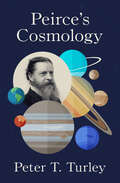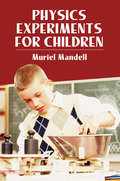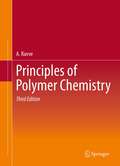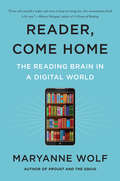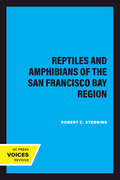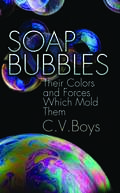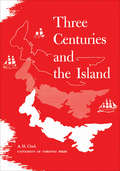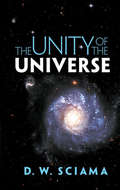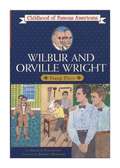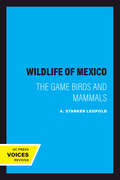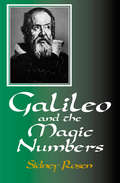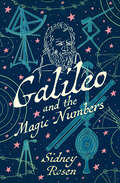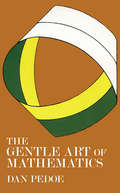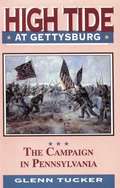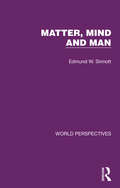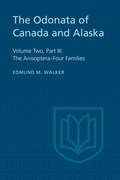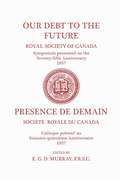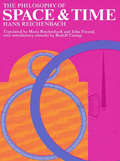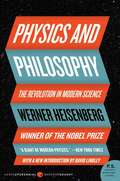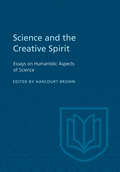- Table View
- List View
Peirce's Cosmology
by Peter T TurleyA critical sketch of Charles Sanders Peirce&’s beliefs on the origin of the universe and its evolutionary development.Charles Sanders Peirce was a nineteenth-century American philosopher and logician known as the father of pragmatism. He devoted much attention to the subject of cosmology, or the origin and development of the universe, but he did not produce substantial work on the subject. In this text, Peter T. Turley collects and analyzes Peirce&’s writings on what he called &“physical metaphysics.&” Peirce&’s Cosmology offers a view of nature that may seem commonplace today, but in his time, it represented a break with traditional theories of philosophy and science. His trailblazing writings and Turley&’s analysis are sure to be of interest to readers of many schools of thought.
Physics Experiments for Children (Dover Children's Science Books)
by Muriel MandellWhat better way is there to learn than by doing? This unusual book enables children to carry out more than 103 different experiments and demonstrations, carefully planned to illustrate principles of modern science. Clear step-by-step instructions, frequent diagrams, and clear statements of conclusions all enable the young student to carry through these experiments with minimal supervision, yet full success.The science projects included demonstrate what things are made of and how substances are affected by the different forms of energy, heat, light, sound, mechanical energy, electricity, and magnetism. The experiments show how a thermometer measures temperature, how an electric bulb gives light, how shadows are formed, how a stethoscope works, how to make a periscope, how to make a rainbow, how straws work, how water changes size, and many other fascinating facts. Little is required in the way of equipment other than simple materials found at home, such as bottles, cardboard, wire, nails, cork, paper, and magnets.This volume offers upper grade school, junior high school, and high school students a very entertaining way to enrich their background in science and its applications. It is also a very valuable aid to parents, teachers, and others who wish to make clear, forceful demonstrations to children.
Principles of Polymer Chemistry
by A. RavveThis successful textbook undergoes a change of character in the third edition. Where earlier editions covered organic polymer chemistry, the third edition covers both physical and organic chemistry. Thus kinetics and thermodynamics of polymerization reactions are discussed. This edition is also distinct from all other polymer textbooks because of its coverage of such currently hot topics as photonic polymers, electricity conducting polymers, polymeric materials for immobilization of reagents and drug release, organic solar cells, organic light emitting diodes. This textbook contains review questions at the end of every chapter, references for further reading, and numerous examples of commercially important processes.
Reader, Come Home: The Fate of the Reading Brain in a Digital World
by Maryanne WolfFrom the author of Proust and the Squid, a lively, ambitious, and deeply informative epistolary book that considers the future of the reading brain and our capacity for critical thinking, empathy, and reflection as we become increasingly dependent on digital technologies. <P><P>A decade ago, Maryanne Wolf’s Proust and the Squid revealed what we know about how the brain learns to read and how reading changes the way we think and feel. Since then, the ways we process written language have changed dramatically with many concerned about both their own changes and that of children. New research on the reading brain chronicles these changes in the brains of children and adults as they learn to read while immersed in a digitally dominated medium. <P><P>Drawing deeply on this research, this book comprises a series of letters Wolf writes to us—her beloved readers—to describe her concerns and her hopes about what is happening to the reading brain as it unavoidably changes to adapt to digital mediums. Wolf raises difficult questions, including: <P><P>Will children learn to incorporate the full range of "deep reading" processes that are at the core of the expert reading brain? <P><P>Will the mix of a seemingly infinite set of distractions for children’s attention and their quick access to immediate, voluminous information alter their ability to think for themselves? <P><P>With information at their fingertips, will the next generation learn to build their own storehouse of knowledge, which could impede the ability to make analogies and draw inferences from what they know? <P><P>Will all these influences, in turn, change the formation in children and the use in adults of "slower" cognitive processes like critical thinking, personal reflection, imagination, and empathy that comprise deep reading and that influence both how we think and how we live our lives? <P><P>Will the chain of digital influences ultimately influence the use of the critical analytical and empathic capacities necessary for a democratic society? <P><P>How can we preserve deep reading processes in future iterations of the reading brain?Who are the "good readers" of every epoch? <P><P>Concerns about attention span, critical reasoning, and over-reliance on technology are never just about children—Wolf herself has found that, though she is a reading expert, her ability to read deeply has been impacted as she has become, inevitably, increasingly dependent on screens. <P><P>Wolf draws on neuroscience, literature, education, technology, and philosophy and blends historical, literary, and scientific facts with down-to-earth examples and warm anecdotes to illuminate complex ideas that culminate in a proposal for a biliterate reading brain. Provocative and intriguing, Reader, Come Home is a roadmap that provides a cautionary but hopeful perspective on the impact of technology on our brains and our most essential intellectual capacities—and what this could mean for our future.
Reptiles and Amphibians of the San Francisco Bay Region (California Natural History Guides #3)
by Robert C. StebbinsThis title is part of UC Press's Voices Revived program, which commemorates University of California Press’s mission to seek out and cultivate the brightest minds and give them voice, reach, and impact. Drawing on a backlist dating to 1893, Voices Revived makes high-quality, peer-reviewed scholarship accessible once again using print-on-demand technology. This title was originally published in 1959.This title is part of UC Press's Voices Revived program, which commemorates University of California Press’s mission to seek out and cultivate the brightest minds and give them voice, reach, and impact. Drawing on a backlist dating to 1893, Voices Revived</DIV
Soap Bubbles: Their Colors and Forces Which Mold Them
by C. V. BoysAn excellent primer and the classic work on the topic of soap bubbles and films, this book employs simple experiments to establish a practical basis for the existence and function of surface tension and energy minimization. Dozens of experiments require nothing more than soap, straws, and bits of rubber, yet they impart profound and fundamental concepts relating to the science of fluids. Geared toward readers without much background in the subject, the book begins without difficult calculations and concludes with only the simplest equations. Lucid and concise experiments allow observers to formulate their own practical understanding of soap bubbles and provide a foundation for more serious studies. More than 80 illustrations complement the text.
Three Centuries and the Island
by Andrew Hill ClarkThis study is one of the first in the field of historical geography to be published in Canada. Written after exhaustive research, it uses a particular approach to the study of historical agricultural geography which concentrates on the use of basic distributional evidence for the description and interpretation of the changing character of any region through any period of time. By the analysis of over 1200 maps, some of which form part of the text of the book, Professor Clark studies agriculture as the dominant economic activity of Prince Edward Island and traces with remarkable clarity through the changing patterns of land culture throughout the province.The book begins with a description of the natural geography of the Island which, despite its small size, shows surprising variety. It goes on to prove the necessity for careful consideration of the background of habit and prejudice of groups of different origin when studying the changing geographies of land use.The settlement of the Island is traced from the time it was used as a summer campground by the Micmac Indians. Details of the arrival of the first Acadians, the transfer to British rule, and the subsequent influx of Scottish, Irish, Loyalist, and English stock are given together with evidence of the effect their coming had on the agriculture of the region. One hundred and fifty-five maps and sixteen tables to illustrate the distribution of population by area and origin, changes in kind and distribution of crops, census of livestock, etc., from the early eighteenth century to the present day, and from the days when the potato was unknown as a crop through the fur-farming era.The author presents this study as part of his life-work, a programme of research on the settlement overseas in the seventeenth, eighteenth, and nineteenth centuries of the people from the British Isles. He is descended from Prince Edward Island settlers and writes of the province from a background of personal knowledge of, and affection for, the land of his forbears.
The Unity of the Universe
by D. W. SciamaDoes the universe consist of independent objects, or is it a single unit? Are some of its features accidental, or can they all be explained in theoretical terms? This accessible book on cosmology addresses profound questions about the universe, and it offers elegant answers in simple, straightforward terms. Written by a distinguished cosmologist, it assumes no knowledge of physics or astronomy and illustrates its explanations with figures and compelling photos. The first part ventures back to the early Greek astronomers, who were the first to measure the Earth's size and the distance to the sun and the moon. It also examines the latter-day discoveries of distant galaxies, achieved with giant telescopes and mathematical calculations. The second part explores modern theories, including the author's own conviction that the universe is a single unit and that the behavior of nearby matter is strongly influenced by distant regions of the universe. A student of Fred Hoyle and Paul Dirac and a teacher of Stephen Hawking, D. W. Sciama is best known for his work on general relativity and black holes. Scientific American acclaimed his survey as "an engrossing book" and "an invigorating intellectual exercise that any mature reader can enjoy."
Wilbur and Orville Wright: Young Fliers (Childhood of Famous Americans Series)
by Augusta StevensonPresents the fictionalized boyhood of the brothers who flew the first airplane in 1903.
Wildlife of Mexico: The Game Birds and Mammals
by A. Starker LeopoldThis title is part of UC Press's Voices Revived program, which commemorates University of California Press’s mission to seek out and cultivate the brightest minds and give them voice, reach, and impact. Drawing on a backlist dating to 1893, Voices Revived makes high-quality, peer-reviewed scholarship accessible once again using print-on-demand technology. This title was originally published in 1959.
Willy Ley's Exotic Zoology
by Willy LeyThe extremely diverse inhabitants of Willy Ley's extraordinary zoo all have one thing in common: there is or has been a mystery about them. But Willy doesn't just describe the animals or the mystery, he also digs deep in the records and stories about those mysteries to solve as many as possible--from fabled unicorns and mermaids, to when we realized dinosaurs were real, to the ever charming dodo, to real monsters of the sea and beyond.
Farm Prices: Myth and Reality
by Willard W. CochraneThis book deals with the price-income problems of commercial agriculture in the United States. The purpose of this book is to bring the best in modern analysis--information, economic logic, and social theory--to bear on the price-income problems of commercial agriculture.
Galileo and the Magic Numbers
by Sidney RosenSixteenth century Italy produced a genius who marked the world with his studies and hypotheses about mathematical, physical and astronomical truths. His father, musician Vincenzio Galilei said, &“Truth is not found behind a man&’s reputation. Truth appears only when the answers to questions are searched out by a free mind. This is not the easy path in life but it is the most rewarding.&” Galileo challenged divine law and the physics of Aristotle, and questioned everything in search of truths. And it was through this quest for truth that he was able to establish a structure for modern science.
Galileo and the Magic Numbers
by Sidney RosenThis &“enjoyable&” biography of the brilliant astronomer will intrigue young people who are &“bored with the textbook approach to science&” (The New York Times Book Review). Sixteenth century Italy produced Galileo, a genius who marked the world with his studies and hypotheses about mathematical, physical, and astronomical truths. His father, musician Vincenzio Galilei said, &“Truth is not found behind a man&’s reputation. Truth appears only when the answers to questions are searched out by a free mind. This is not the easy path in life but it is the most rewarding.&” Galileo challenged divine law and the physics of Aristotle, and questioned everything in search of truths. And it was through this quest for truth that he was able to establish a structure for modern science.
The Gentle Art of Mathematics
by Dan PedoeMathematical games, probability, the question of infinity, topology, how the laws of algebra work, problems of irrational numbers, and more. 42 figures.
High Tide at Gettysburg: The Campaign in Pennsylvania
by Glenn TuckerThe author tries to present how the Gettysburg battle was won and lost, and why the Gettysburg campaign remains such an appealing study to large numbers even after the passing of nearly a century.
Matter, Mind and Man (World Perspectives #9)
by Edmund W. SinnottOriginally published in 1957 and written by one of the 20th Century’s leading botanists and a fierce advocate of organicism, this book explores concepts about man and his relation to life and the universe, and about the great creative and spiritual powers within and around him. The author provides answers to perennial human questions whilst discussing the problems of sin, justice, ugliness and beauty.
The Odonata of Canada and Alaska: The Anisoptera–Four Families
by Edmund WalkerDr. Walker makes a signal contribution in gathering together all available information on the dragonflies of Canada and Alaska. The order as a whole and the zygoptera are covered. The treatment is not confined to taxonomy and geographical distribution, but includes data on habitats, seasons of adult life, and brief notes on habits when these are available.
Our Debt to the Future: Royal Society of Canada, Symposium presented on the Seventy-fifth Anniversary 1957 (The Royal Society of Canada Special Publications #2)
by E.G.D. MurrayAT ITS ANNUAL MEETING in 1957, the Royal Society of Canada, celebrating the seventy-fifth anniversary of its foundation, departed from the accustomed pattern of its meetings. Instead of assembling in separate sections, Fellows from each Section of the Society were asked to contribute to a conspectus, focused by their specialized knowledge and trained discrimination, to reveal to the Society and to others certain trends and tendencies in Canada. Subjects and contributors are: "These Seventy-Five Years" (Presidential Address by W. A. Mackintosh); "The Roles of the Scientist and the Scholar in Canada's Future" (W. A. Mackintosh, David L. Thomson); "The Penalties of Ignorance of Man's Biological Dependence" (E. G. D. Murray, K. W. Neatby, I. McT. Cowan, G. H. Ettinger, R. H. Manske); "The Social Impact of Modern Technology" (N. A. M. MacKenzie, V. W. Bladen, E. W. R. Steacie, W. H. Watson); "Our Economic Potential in the Light of Science" (H. C. Gunning, J. E. Hawley, L. M. Pidgeon, B. S. Keirstead, Maurice Lamontagne); "Human Values and the Evolution of Society" (G.-H. Lévesque, T. W. M. Cameron, A. S. P. Woodhouse, R. Elie, Roy Daniells); "Let Us Look to Our Human Resources" (F. H. Underhill, J. K. W. Ferguson, L.-P. Dugal, W. B. Lewis). The volume is further prefaced by the address given by His Excellency the Right Honourable Vicent Massey, Governor-General of Canada, "The Weighing of Ayre."
The Philosophy of Space and Time
by Hans ReichenbachAn important landmark in the development of the empiricist conception of geometry, this book is still one of the clearest and most valuable expositions of the crisis in physical science and mathematics occasioned by the advent of the non-Euclidean geometries. With unusual depth and clarity, it covers the problem of the foundations of geometry, the theory of time, the theory and consequences of Einstein's relativity including: relations between theory and observations, coordinate definitions, relations between topological and metrical properties of space, the psychological problem of the possibility of a visual intuition of non-Euclidean structures, and many other important topics in modern science and philosophy.While some of the book utilizes mathematics of a somewhat advanced nature, the exposition is so careful and complete that most people familiar with the philosophy of science or some intermediate mathematics will understand the majority of the ideas and problems discussed.Partial CONTENTS: I. The Problem of Physical Geometry. Universal and Differential Forces. Visualization of Geometries. Spaces with non-Euclidean Topological Properties. Geometry as a Theory of Relations. II. The Difference between Space and Time. Simultaneity. Time Order. Unreal Sequences. Ill. The Problem of a Combined Theory of Space and Time. Construction of the Space-Time Metric. Lorentz and Einstein Contractions. Addition Theorem of Velocities. Principle of Equivalence. Einstein's Concept of the Problems of Rotation and Gravitation. Gravitation and Geometry. Riemannian Spaces. The Singular Nature of Time. Spatial Dimensions. Reality of Space and Time.
Physics and Philosophy
by Werner HeisenbergThe seminal work by one of the most important thinkers of the twentieth century, Physics and Philosophy is Werner Heisenberg's concise and accessible narrative of the revolution in modern physics, in which he played a towering role. The outgrowth of a celebrated lecture series, this book remains as relevant, provocative, and fascinating as when it was first published in 1958. A brilliant scientist whose ideas altered our perception of the universe, Heisenberg is considered the father of quantum physics; he is most famous for the Uncertainty Principle, which states that quantum particles do not occupy a fixed, measurable position. His contributions remain a cornerstone of contemporary physics theory and application.
The Pirates of Shan (Rick Brant, # #13)
by John BlaineTwo Spindrift scientists are kidnapped from their work in the Philippine Islands. With the help of Dr. Zircon and a Hindu boy, Rick and Scotty try to find and rescue them. They learn that the ancient Pirates of Shan are still active and trace them to their stronghold to find the scientists.
Primer of Genetic Analysis
by Gerald Braver Jenna J. Hellack David S. Durica James N. Thompson Jr.This third edition of a student-tested primer provides guided instruction in the analysis and interpretation of genetic principles and problem solving. All core areas of genetics are covered. Each section is introduced with a summary of key concepts and terms. A series of problems, graded from simple to more complex, then allows students to test their understanding of the material. Each question is accompanied by a detailed explanation. This new edition includes additional problems, extensively expanded coverage of molecular biology throughout, new overview chapters, and an expanded glossary.
Science and the Creative Spirit
by Harcourt BrownIn the world of today, men on both sides of the science-humanities barrier feel an urgent need for mutual understanding. This symposium sponsored by the American Council of Learned Societies, stressed that it is only in a spirit of disinterested yet sincere evaluation that science and humanism can escape disastrous consequences in the future. Karl W. Deutsch (M.I.T.) deals with the general area of interplay between the sciences and the non-scientific aspects of our culture. F.E.L. Priestley (University of Toronto) discusses the impact of science on English literature. David Hawkins (University of Colorado) surveys the anthropological background of science. Harcourt Brown (Brown University) gives an account of the influence of the scientific outlook in French literary culture, and contributes an introduction explaining how the book came to be written.
